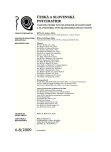Psychosomatic Transformation of Peripheral Somatic Disorder (Benign Paroxysmal Position Verig)
Authors:
D. Balaštík
Authors‘ workplace:
Fakultní nemocnice u sv. Anny, Brno
ředitel Ing. P. Koška, MBA
Published in:
Čes. a slov. Psychiat., 105, 2009, No. 6-8, pp. 290-293.
Category:
Case Report
Overview
Case report of a female patient with benign paroxysmal position vertig is demonstrating how the mental predispositions change peripheral somatic disorder into a somatopsychic and psychosomatic disorder. It indicates the possible influence of older complex traumas, which are constellated again by the pressure of somatic disorder. This is supposedly enabled by the resemblance of the mental symptom of the somatic disorder and the complex and, perhaps, their mutual interconnection by perceptional channel (in our case kinesthetic). Further the importance of casual and final aspects in psychotherapy and diagnostics of psychosomatic disorder is emphasized. The study indicates not only the need for the active identification of all pathogenic complexes but also confrontation with them in case of a successful psychotherapy. Significant information can be acquired from analysis dreams and drawings.
Key words:
benign paroxysmal position vertig, psychosomatic disorder, complex, causality, finality, analytic psychotherapy.
Sources
1. Danzer, G.: Závrať monologické existence. In: G. Danzer (ed.): Psychosomatika. Praha, Portál, 2001, s. 147-154.
2. Gilain, C., Englebert, A.: Vertigo and psychological disorders. In: R. Boniver (ed): Vertigo and dizziness. B.-Ent. Formerly Acta Oto-Rhino-Laryngologica Belgica, 4, 2008, (Suppl. 8), pp. 49-58.
3. Jung, C. G.: Obecná hlediska psychologie snu. In: Jung C. G: Výbor z díla, sv. I., Brno, Nakladatelství T. Janečka, 1996, s. 161-217.
4. Jung, C. G.: Obecné pojednání k teorii komplexu. In: tamtéž, s. 241-258.
5. Jung., C. G.: O synchronicitě. In: tamtéž, sv. 2, 1997, s. 357-372.
6. Jung, C.G.: Vztahy mezi já a nevědomím. In: tamtéž, sv. 3, s. 9-156.
7. Jung, C. G.: Psychologie přenosu. In: tamtéž, s. 159-336.
8. Jung, C. G.: Snové symboly individuačního procesu. In: tamtéž, sv. 5, s. 53-272.
9. Mindel, A.: Telo a sny. Bratislava, Stimul, 1992. 104 s.
10. Novotný, M., Hahn, A., Boleloucký, Z., Vaverková, H.: Závratě. Diagnostika a léčba. Stuttgart, Aesopus Verlag, 1977.
11. Rainwater, J.: You´re in Charge: A Guide to Becoming Your Owen Therapist. 7 print., Marina del Rey, DeVorss&Comp., 1989, p. 221.
12. Skutil, J., Novotný, M., Kostřica, R.: The etiological factors and therapy for Benign Paroxysmal Vertigo: Evaluation of therapeutical possibilities. Otorinolaringol., 57, 2007, pp. 41-49.
Labels
Addictology Paediatric psychiatry PsychiatryArticle was published in
Czech and Slovak Psychiatry

2009 Issue 6-8
Most read in this issue
- Neuromechanisms of Addictive Substances, Reward System
- Schizophrenia in Mentally Retarded Patients, Diagnostic Consideration and Practical Experience
- Psychosomatic Transformation of Peripheral Somatic Disorder (Benign Paroxysmal Position Verig)
- Addictive Behavior on the Internet and Its Treatment
